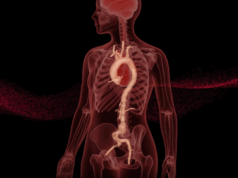This advertorial is sponsored by Bentley.
The range and complexity of vascular pathologies that interventionalists face necessitates a complete and comprehensive solution. Bentley, with its coronary, peripheral and aortic iterations (ranging from 2.5 to 30mm) of the BeGraft balloon-expandable covered stent, claims to offer such a solution. In this interview with Vascular News, two interventional radiologists give weight to this claim, sharing their clinical experience and opinions on the BeGraft covered stent portfolio.
Mohamad Hamady, senior consultant vascular interventional radiologist and professor of practice in image-guided surgery and interventional radiology at Imperial College London (London, UK), states that covered balloon-expandable stents play an important role in his practice. He underlines an unmatched range of features for a wide range of patients and pathologies that make the BeGraft family “the first thing we look for” when choosing equipment for a case. Christoph Binkert, chair of radiology and nuclear medicine and head of interventional radiology at Kantonsspital Winterthur (Winterthur, Switzerland) concurs, citing in particular his extensive experience with the BeGraft aortic, which he describes as a “lifesaver” that “needs to be on the shelf of every interventional radiologist”.
What role do covered balloon-expandable stents play in your department?

MH: Covered balloon-expandable stents play a pivotal role in our department because they are suitable for treating a range of pathologies, from aneurysmal disease to occlusive disease. With these pathologies, we need a stent that is safe to deliver, durable, and enables technical success. In many instances and in many pathologies, in fact, it seems covered balloon-expandable stents are increasingly used because they give superior results to bare metal stents.
CB: In our department, covered balloon-expandable stents also play a central role. We use these devices mainly for fenestrated stent grafts or there is irregular, odd-looking plaque. Finally, yet importantly, if there is a rupture during an intervention, it is good to know that you can place a covered balloon-expandable stent to resolve a potentially dangerous problem.
Why do you need covered balloon-expandable stents that range from 2.5 to 30mm in diameter for your procedures?
MH: It is important that covered balloon-expandable stents are available in a range of diameters because this increases the number of patients and pathologies we are able to treat, in elective and emergent settings. For example, we need small diameter stents in certain cases where the native vessel, which carries the aneurysm, is of a small diameter. Instead of sacrificing that artery or branch, the smaller diameter stent gives us the ability to navigate through those small vessels. Take an aneurysm in the hepatic or splenic artery, for instance, the small diameter stents from the Bentley family offer a low profile, good crossability, and flexibility, reasonable adherence of the stent to balloon as well as smooth conformability to the vessel anatomy.

CB: Furthermore, you want these stents to fit more or less exactly to the size of the vessel. If you have too small of a stent, it will not attach and the blood will flow around it, which will be a nightmare, but if you oversize it too much then you risk damaging the vessel. Therefore, it is very important you have a good size matrix. Typically, I tend to slightly oversize, but not by much.
Do the BeGraft products differ from other covered balloon-expandable stents on the market and if so, how?
MH: The BeGraft products have a number of unique features. They are available in a wide range of lengths and diameters and have two shaft lenghts so they can be used via either the femoral or the antegrade approach. Depending on single or double ePTFE layers and integrated scaffolding, the stent can give higher or standard radial force. They have a lower profile than their competitors do, and this is an important feature, especially when we are talking about using a radial or brachial approach. In general, if we can achieve a task with a smaller sheath, this is an advantage because it makes the procedure less invasive. We know that when the procedure becomes less invasive, it is quicker, carries fewer complications, and is likely more successful.
CB: I would like to mention again the small profile compared to other stents. Older versions of covered stents needed a much larger sheath and that was a big disadvantage, because sometimes when you are in a difficult situation you have to be able to get the stent in, ideally without changing the sheath. This is something Bentley worked on and the small profile is now a key feature of the BeGraft family.
Can you give an example of a case involving the BeGraft Coronary?
MH: I remember a case in which the combination of small diameter, low profile, flexibility and good crossability that the BeGraft coronary offers enabled me to treat a tiny vessel. This case involved a hepatic artery aneurysm, which was a fusiform aneurysm and so involved the entire length of that aneurysmal segment. In addition, it was in a small diameter vessel, around 3.8mm, and so it was difficult to use other covered stents. I could not treat the aneurysm unless I embolised and sacrificed all vessels, which is not something I wanted to do. The BeGraft coronary enabled me to treat that vessel successfully.
Can you give an example of a case involving the BeGraft aortic?
MH: The BeGraft aortic comes in various lengths and diameters, and can go up to quite large diameters of around 30mm, and for these reasons I have used it several times, both in aneurysmal and occlusive disease. A particular case that comes to mind involves occlusive disease. The aorta and both iliac arteries needed stenting, and there was a good discrepancy between the normal segment and the diseased segment, with a short involvement of the distal aorta. Because the BeGraft aortic comes with a large diameter but still provides the option of choosing a short length, I was able to use the BeGraft aortic and kissing BeGrafts to perform the Covered Endovascular Reconstruction of Aortic Bifurcation (CERAB) technique, without having to cover a longer segment of the aorta that you do not really need to treat.
CB: The BeGraft aortic is sometimes a lifesaver. I believe this product needs to be on the shelf of every interventional radiologist, especially when you work in the aorta, or in the large iliac, because the vessel diameters are sometimes so large that you require stent diameters only offered by the BeGraft aortic. Also with rupture, it is great to have a BeGraft aortic on hand. In fact, there does not even need to be a Frank rupture, even if you just see a very bad irregularity or a bad dissection the BeGraft aortic is useful here. I remember a tough case, which was a nearly circular calcification of the aorta. I was a little hesitant to treat this patient, but everyone including the patient wanted me to go ahead. Sure enough after angioplasty there was not a Frank rupture, but there was contrast outside the lumen. With the help of an aortic BeGraft a good result could be achieved.
How important is it for you to work with smallest possible sheath compatibilities, and what role does the BeGraft peripheral play in this?
CB: The small sheaths are very important. If I am using the BeGraft for a visceral aneurysm, for example, and you have to place more than a 6Fr sheath in a sometimes-tortuous artery, such as a splenic or hepatic artery, then you are not able to get there. In addition, the small sheath is not a matter of just comfort, it is actually a matter of being able to do the case or not. Especially in the visceral arena, it is important to have a 6Fr available, but not more than that, to get to the place where you want to place the stent.
As interventional radiologists, you are familiar with handling different types of catheters, sheaths and stent systems. Could you summarise the key features of the Bentley BeGraft portfolio?
CB: The BeGraft product family covers all areas and the technology allows physicians to use relatively small delivery systems. This helps us to get to the point where we want to be, and, in emergency cases, we do not have to change the sheath, which is very important. The BeGraft products also have good trackability, and so they travel nicely. This is another new feature, in fact. The old stents were slightly bulky, and so a lot of the time you were not able to get to the point of deployment. This is something else that Bentley addressed and now the stents’ trackability is a key feature.
MH: The main features of the BeGraft product family are radiological visibility, flexibility, crossability, the lowest profile on the market, a wide range of lengths and diameters, good flaring, and minimal foreshortening. In addition, they have a very good radial force, and this is especially important when we use the branched aortic stent grafts to avoid a kink or compression of the artery such as we see sometimes in the coeliac trunk or renal branch with unfavourable take-off angle. These features make the BeGraft family the first thing we look for when we are choosing equipment for a case.
Case images


Case images courtesy of Maria Antonella Ruffino, Interventional Radiology Department, EOC Lugano, Lugano, Switzerland













